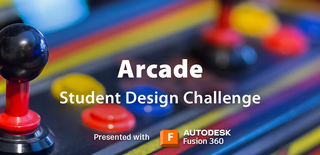Introduction: MAME Arcade Cabinet
Hi Everyone!
A little under two years ago, I got to join a small group building a fully original CNC cut arcade cabinet, running on the MAME arcade emulator software! We're all very proud of the final product, and we hope you enjoy it too!
Supplies
For the design phase of this project, all that's needed is a Fusion360 account. If you want to actually build the final design, then access to a CNC cutter, a 3D printer, and/or a good amount of woodworking tools will likely be needed. As for the arcade software and electronics, we used the open source MAME arcade emulator software, easily available for download on several platforms, and bought our arcade parts (joysticks, trackballs etc) from various retailers.
Step 1: Cabinet Design
The cabinet itself should probably be the first thing you design (best to avoid a "cart before the horse" scenario) so here's ours! I'm far from the best designer out there, but the best advice I can give for this phase is to break it into more manageable parts: settling on the side profile of the arcade first before adding sides, shaping the monitor and marquee, etc.
Being mindful of your electronics requirements is also smart, if you're planning to construct the design in real life. Our design stores the main computer in the arcade's base (since we don't need to include room for a coin slot etc) and allows us ample room to wire in the control panel (more on that later.)
Attachments
Step 2: Panel Design
The panel design phase is next. Depending on whether you intend to actually build the full design, this process can take a long time. Little details like mapping out the space between buttons and making sure that every socket (joysticks, buttons, trackballs etc) matches a commercially available part can take a while. While online schematics can help, making prototype designs with cardboard (as shown above) can also be a good low-tech and low-cost way to get a feel for your design and what it takes to wire up the electronic components.
The control panel is probably the most esoteric part of our design. Rather than going for a single panel layout (like you'd see in most machines) we opted to embrace the MAME catalogue's vast array of games by making our control panel modular. We designed and cut a series of control panels that could all be attached to the cabinet's main body, then added different controls to each board so that the arcade could work with any game requirement: a trackball version for Centipede, a classic Dig Dug/Galaga setup (joystick and fire buttons), and a custom Mortal Kombat II board (marked here as "frankenboard), among others. For greater flexibility, we ended up not CNC cutting out each board design, but rather cutting a stack of blank boards, all compatible with the arcade, and then drilling out holes manually---the designs served as a helpful blueprint.
Step 3: Next Steps?
Like with any project, this one doesn't need to go any further than you'd like it to. If you'd like to stick with a digital design, it's entirely ok---what you do next is up to you. For us, having a physical end product was important, and although it added significantly to the project's time and budget, I think we can all agree it was worth it. We even got to have our own "Seinfeld" frogger moment when we needed to get the thing installed across a busy street. Whatever you hope to get out of your project, I hope you enjoy it too!

Participated in the
Arcade Student Design Challenge













